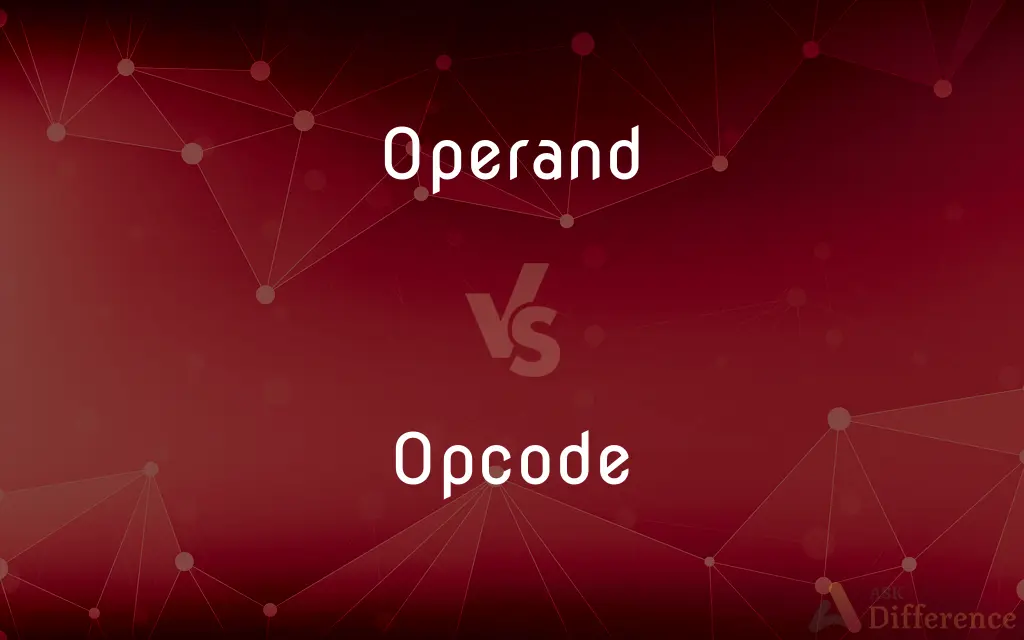Operand vs. Opcode — What's the Difference?
By Tayyaba Rehman — Updated on November 2, 2023
Operand is a value or reference on which an operation is performed, while an opcode is the part of a machine language instruction that specifies the operation to be performed.

Difference Between Operand and Opcode
Table of Contents
ADVERTISEMENT
Key Differences
In computer architecture, an operand is a term used to denote any object that is capable of being manipulated. In an instruction, operands are the data on which the operation is performed, guided by the opcode. An opcode, short for operation code, is the part of the machine language instruction that tells the computer what operation to perform.
Operands can be values, variables, or memory addresses that represent the data. Opcodes are the instructions in the machine code that define the operation for the CPU to execute, such as ADD for addition. Without an opcode, the computer would not know what to do with the operands.
Operands are crucial for the execution of instructions as they act as the subject of the operations. Opcodes, however, are like verbs in a sentence, dictating the action to be taken. While the operand is what is being operated on, the opcode is the command that sets the operation in motion.
The operand can be thought of as the content, while the opcode can be seen as the function to be applied to that content. For instance, in the machine instruction "ADD A, B", "A" and "B" are operands, and "ADD" is the opcode. The operands are acted upon by the operation specified by the opcode.
In an assembly language, each instruction corresponds to one opcode. This opcode determines which of the several possible operations the computer's control unit will carry out. The operands are the subjects of these operations, varying widely depending on the opcode used. Together, they form a complete instruction for the computer to execute.
ADVERTISEMENT
Comparison Chart
Definition
Data on which operations are performed
Instruction that specifies the operation
Role in Instruction
Acted upon by the operation
Dictates the action to be taken
Examples
Constants, variables, memory addresses
ADD, SUB, MUL, DIV
Dependency
Depends on the operation for context
Independent, defines the operation context
Variability
Can be numerous in a single instruction
Usually one per machine instruction
Compare with Definitions
Operand
May refer to a register, a constant, or memory location in assembly.
The register AX served as an operand in the assembly code.
Opcode
Defines the instruction's operation, such as arithmetic or logic functions.
The opcode 'INT' triggers a software interrupt.
Operand
A variable or value that an instruction manipulates.
The operand x was incremented by one in the loop.
Opcode
It is a binary or hexadecimal code interpreted by the control unit.
Each opcode in the program corresponds to a specific machine operation.
Operand
It can be an immediate value, direct address, or indirect reference.
The value 10, an immediate operand, was added to the total.
Opcode
A portion of a machine language instruction that specifies an operation.
The opcode for addition instructed the CPU to add two numbers.
Operand
An entity on which an operator acts.
In the expression 5 * 4, both 5 and 4 are operands.
Opcode
An opcode can have zero or more associated operands.
The opcode 'MOV' transfers data from one location to another.
Operand
In computing, operands are essential for computation instructions.
Operand 'A' is now loaded into the buffer for processing.
Opcode
In assembly language, mnemonics represent opcodes.
'JMP' is the mnemonic opcode for the jump instruction.
Operand
A quantity on which a mathematical or logical operation is performed.
Opcode
(computing) A mnemonic used to refer to a microprocessor instruction in assembly language.
Operand
In mathematics an operand is the object of a mathematical operation, i.e., it is the object or quantity that is operated on.
Opcode
2010 and the .NET 4 Platform|page=655
Operand
A quantity to which an operator is applied (in , the operands of the subtraction operator are 3 and ).
Opcode
In computing, an opcode (abbreviated from operation code, also known as instruction machine code, instruction code, instruction syllable, instruction parcel or opstring) is the portion of a machine language instruction that specifies the operation to be performed. Beside the opcode itself, most instructions also specify the data they will process, in the form of operands.
Operand
The symbol, quantity, or thing upon which a mathematical operation is performed; - called also faciend.
Operand
A quantity upon which a mathematical operation is performed
Common Curiosities
Can an instruction have more than one operand?
Yes, instructions can have multiple operands, depending on the operation.
Is an opcode the same as a command?
Essentially, yes. An opcode is a low-level command for the processor.
How are operands used in programming?
In programming, operands are used in expressions with operators to perform calculations or manipulate data.
Do all programming languages use opcodes?
Directly, no. Opcodes are used at the machine language level, but high-level programming languages abstract these into human-readable commands.
What is an operand?
An operand is a value or variable that the operator acts upon in a programming or mathematical expression.
How does the computer recognize opcodes?
The computer's processor has a defined instruction set with opcodes it recognizes to perform specific operations.
Can operands be both input and output in an operation?
Yes, depending on the instruction, an operand can be used for input, output, or both.
What is an opcode?
An opcode (operation code) is the portion of a machine language instruction that specifies the operation to be performed.
Is opcode the same as the instruction?
The opcode is part of the instruction, specifically indicating the operation.
How are operands represented in assembly language?
Operands in assembly are represented by identifiers, numbers, or expressions.
Where is the opcode found in an instruction?
The opcode is typically found at the beginning of a machine language instruction.
Are opcodes and operands architecture-specific?
Yes, both are specific to the computer architecture and the instruction set used by the processor.
Are operands always numbers?
No, operands can also be variables, memory addresses, or data structures.
Do all machine instructions include an opcode?
Yes, all machine instructions must include an opcode to be valid.
Can the opcode be a variable?
No, the opcode is a predefined code that dictates an operation.
Share Your Discovery

Previous Comparison
Guy vs. Guys
Next Comparison
Advocate vs. AdvocatorAuthor Spotlight
Written by
Tayyaba RehmanTayyaba Rehman is a distinguished writer, currently serving as a primary contributor to askdifference.com. As a researcher in semantics and etymology, Tayyaba's passion for the complexity of languages and their distinctions has found a perfect home on the platform. Tayyaba delves into the intricacies of language, distinguishing between commonly confused words and phrases, thereby providing clarity for readers worldwide.















































